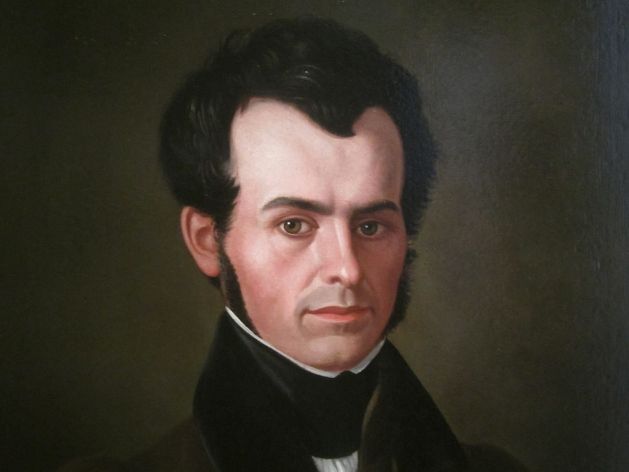Note: The hedge fund-owned newspaper chain MediaNews Group recently laid off several people at its Massachusetts papers, including sports editor Dennis Whitton of The Sun in Lowell. Whitton posted a farewell column on The Sun’s website and linked to it on Twitter, but when I tried to read it, it was gone — taken down (by management), he said in a tweet. (The column did appear in print.) An anonymous person with access to the CMS forwarded it to me, and I was able to verify that it was authentic. Here is Whitton’s farewell:
40 years of memories
By Dennis Whitton
“And then one day you find, ten years have got behind you. No one told you when to run, you missed the starting gun…”
— Pink Floyd, “Time”
LOWELL — It’s more like 40 years have got behind me. Where have they gone? What do I have to show for them? Can I get some of them back?
After 35 years as The Sun’s sports boss and another 5-6 behind that as a reporter, co-op, cub and otherwise, your intrepid correspondent will be leaving the building this afternoon for the final time.
Corporate cost-cutting is the culprit. Apparently I was making too much money to suit the suits, even with years of frozen wages. I didn’t realize I was making so much. I would have spent more.
Our assistant sports boss, Barry Scanlon, is in the same liferaft. That’s a real head-scratcher because Barry was the staff workhorse and he loved what he did for the most part and did it extremely well. Like me, he took maybe two sick days in 22 years. But he, too, was unknowingly making too much money.
My super-supportive wife Jan says I should use the term “let go” when talking about this stuff because it sounds better than “laid off.”
It probably also sounds better than fired, downsized, axed, canned, dumped, released and forced out, too. But any way you cut it, we’re down to the final countdown in a job I’ve held since before that ball went through Bill Buckner’s legs.
If I sound bitter you’re reading me wrong. With all the technology now in play it’s a young person’s game. I’ve probably overstayed my “sell by” date and now I’m looking forward to the next chapter. Of the book I’m reading. Sitting on the beach.
At least the ax wasn’t performance-related. I know that because the suits in question have no idea what Barry and I did or how we did it. In the end we were numbers on a spreadsheet. There is one major downside to the affair: According to the exit agreement, my discounted employee newspaper subscription will be rolled over to the regular customer rate at the end of the month. Damn.
Everybody knows newspapers are yesterday’s news, useful mainly to parents making scrapbooks for their high school heroes. In the Internet age there isn’t much we can tell you in the rag that you couldn’t have found out 12 hours ago. Advertisers know this, which is why newspapers are circling the drain. Which is why we’ve been let go, and a number of other good people before and after us.
Those were the days.
In looking back for this “farewell column” that the aforementioned Jan has pressured me to write, I realize nearly all of my most interesting times in the game came in the previous century. After that I became a cynical curmudgeon.
So in a nutshell, and with apologies for the overuse of the dreaded pronoun “I,” here are some of my memories:
One of my first assignments as a Northeastern (Class of ’80) co-op student in the Sun sports department was the 1978 Beanpot. Of course the Blizzard of ’78 hit and I was stuck wandering Boston for five days. At least I didn’t bail. A true newspaperman.
In October of that same year I was in the overflow “press box” on the left field roof at Fenway Park when Bucky Dent’s home run cleared the fence so close to me I could almost read Bowie Kuhn’s signature on the baseball.
I covered a lot of Red Sox, Bruins and Celtics games in that time period (much of it while still in college) and even went on several Sox road trips when Charlie (not yet Chaz) Scoggins was on vacation. Milwaukee, Baltimore, Cleveland, the Bronx, Arlington, Texas — all the garden spots. I rode the team buses (Luis Tiant was a hoot. Nobody talked to Yaz. The nicest guy was Jack Brohamer) and stayed at the team hotels.
Jack Costello, the editor whose family owned the paper, wasn’t averse to spending money, at least where travel was concerned (lunch was another matter). Now we don’t even go to the Garden because it costs too much to park.
In September of 1979 I was off to Syracuse for a feature story on Ayer’s Joe Morris, who was setting records for the Orange. From there I detoured down to Madison Square Garden where I covered Larry Bird’s first exhibition game with the Celtics. Still have the press pass to prove it.
In 1982, the paper sent me to Kitchener, Ontario, for three days to do a profile of junior hockey superstar Brian Bellows because the Bruins had the first overall pick in the draft. The stories came out OK, but the B’s went and drafted Gord Kluzak instead.
Jack sent me to Augusta National to cover five Masters Tournaments, ending with Tiger’s historic win in 1997. Got to play the course in 1990 and made birdie on the par-3 sixth with a rented Cannon 5-iron to six feet. Been living off that story ever since. Also got to take the ferry over to Long Island for two U.S. Opens at Shinnecock Hills.
Speaking of golf, in 1999 we were double-teaming the Ryder Cup in Brookline until I told Dave Pevear on Saturday night to go ahead and cover the Patriots’ game on Sunday rather than come to the U.S. funeral at TCC. A case of over-managing.
In 1980, I remember covering the horrendous clubhouse fire at Rockingham Park. It was the morning after I hit the last race, with Skip Row paying $10.20 (I kept the program).
Closer to home there was a story on Dave Boutin, a ULowell catcher from Pawtucketville who was dying of cancer. That one has always stuck with me. Dave and his mother Fleurette were a source of inspiration, even for a cynic. Absolute profiles in courage.
In 1987, they sent me to Pasadena, Calif., for Super Bowl XXI to do stories on Ayer’s Joe Morris (again), by now the Giants’ star running back. From there Mr. Costello had me drive down to San Diego to do a piece on Dennis Conner, who had brought the America’s Cup back to the States in historic fashion.
Dennis was not even in the country, but there was some good yachting talk with various officials at the leather-and-mahogany San Diego Yacht Club. Nothing like some good yachting talk on the company’s dime. At least I got to see the actual Cup.
Westford golfer Pat Bradley always made time for me whenever I needed a story. I attended her Hall of Fame induction dinner in Boston in 1991 (still have the commemorative wine glass) — and shockingly ran into her atop Mt. Washington last year after she had hiked up through thick fog at age 67.
The Golden Gloves were my beat through the ’80s and into the ’90s. I covered Micky Ward’s amateur career (and later Ward-Gatti II), saw Mike Tyson destroy a poor local kid named Jimmy Bisson in 42 seconds in 1983, got to know the tireless Arthur Ramalho and his saint of a wife, Rita, and went on five or six National Golden Gloves trips.
The most memorable of those was in Albuquerque, N.M., when Gloves director Norm Lombardi, “chaperone” Jack Baldwin and I hopped on a small plane to Las Vegas one night. I had to call Ramalho’s hotel room to find out what happened to the heavyweight we had fighting in the tournament and cranked out the story from some cheap hotel off the strip where you had to duck under the TV set when you entered the room.
Norm was obsessed with that casino game where you plug in nickels and they fall into the bin and push other nickels over a cliff for a possible 20-cent payout. Obsessed.
From 1983-85 I left to work with another mentor, Frank Dyer, at the Boston Herald. We had a blast, but there was zero chance to write so I went looking and Lowell happened to be in need of a sports editor. At age 28 I took the job.
Which brings me to the old Sun All-Star sports banquets, usually held at the Windsor (now Lenzi’s) in Dracut. By actual count I did three banquets a year for 23 years until they were discontinued in 2008 — corporate cost-cutting was the culprit.
Introducing shy high school kids and reading about their accomplishments to beaming parents for two-plus hours a night was the drill. I dreaded it at the time but looking back it was a true highlight of my career.
We were able to talk with a ton of area coaches and AD’s and athletes and parents, and it no doubt helped our high school coverage, which was always The Sun’s bread and butter.
There were usually guest speakers, too. Tom Glavine was extremely nervous and kept repeating himself. Now he’s as polished as they come. His girlfriend at the time may have been overserved. Reggie Lewis showed up with a severe burn on his right hand.
A popcorn accident in the kitchen, he told us. Wink wink. Nod nod. Jim Calhoun spoke when he was still at NU and not yet the legend he became at UConn. And there were plenty more.
I covered a Marvin Hagler fight one winter night at the Worcester Centrum and got caught again in a raging blizzard. Unwilling to wait in a long line for gas, I negotiated my beloved but totally unreliable MGB roadster back to Lowell on absolute fumes, barely able to see out the windshield. It finally gave up as I pulled into the old Rex parking lot astride the Sun office. Loved that car.
The Rex was where a Lowell cop moonlighting as a snowplow driver hit my car one night and left a note on the windshield. Thus began a long friendship with Jack Dolan.
So in the interest of wrapping this thing up, let me throw out some other names of people who have helped me along the way, made the journey more enjoyable, and in some cases even became friends:
Jack Costello, Frank Dyer, Mickey Sullivan, Jim Moriarty, Gene Manley, Ken Hughes, Kendall Wallace, Meg Buckley, Shawn Smith, Peter Flynn, Paul Daley, Chris Scott, Jim Campanini, Bill Biswanger, the entire group of sports personnel, past and present, who turned the deadlines we faced every single day into child’s play.
Then there is my aunt Joyce Dalton in Wilmington, who faithfully clipped all of my articles from day one, regardless of topic, passed judgment and sent them down the family line through Auntie Moo.
I know there are others whose names will pop into my head as I drive home after writing this. If that’s you, I apologize.
But as the great Blues Traveler song goes: “It won’t mean a thing in a hundred years.”
— 30 —
Talk about this post on Facebook.






